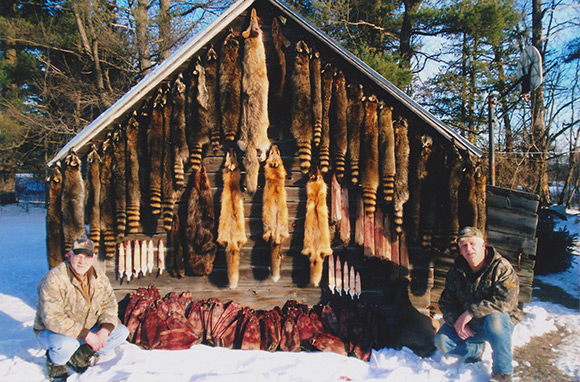 Team Fur News - July 2023
Team Fur News - July 2023
Tom Miranda Returns to F-F-G
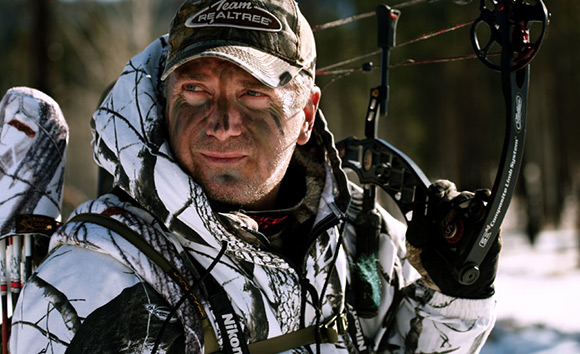
FUR-FISH-GAME welcomes Tom Miranda.
Tom Miranda Returns to FUR-FISH GAME
Television producer, host, trapper and adventure bowhunter Tom Miranda is no stranger to outdoorsmen, and FUR-FISH-GAME is proud to have Tom as a part of Team Fur again, serving as our Editor-at-Large and submitting a monthly column, “Out & About.”
Tom has led a very interesting life. And that's an understatement.
After high school, when many students attended college, Tom went off to the wilds of Michigan’s Upper Peninsula, built his own log cabin and launched his professional trapping career. During the mid-1980s, Tom relocated to Chamberlain, South Dakota, to work as a government trapper and hunter. There, he mastered the art of trapping and honed his skills to a fine edge, using a small airplane to operate a longline trapping operation. Tom eventually produced and starred in a number of how-to trapping videos, the FUR-FISH-GAME Professional Trapping Series, which are still for sale on DVD today. You could order them at https://www.furfishgame.com/store/trapping_videos.html
In 1992, Tom embarked on the second major step of his career, outdoor television.
A bowhunter, Miranda began making hunting videos and soon had his own adventure TV series on ESPN. Self-taught in TV production, Miranda would hire a freelance cameraman to tape his adventures then write, produce and edit the programs himself.
Tom soon became known on ESPN as the “crazy bowhunter” who’d do anything. His adventure show featured adrenaline stunts like sky diving, bull riding and bungie jumping...along with bowhunting.
In 2011, Miranda completed a 13-year quest to capture the archery Super Slam on video. Safari Club International (SCI) record book officials contacted Tom about his hunting accomplishments. A list of species was generated, and after some fact-checking, SCI determined Miranda was very close to accomplishing the World Hunting Award.
Miranda had his mounts scored, entered them with SCI and set out to fill any gaps in his bowhunting collection. This accomplished, Miranda’s full draw archery quest resulted in him taking more than 70 big game animals on six continents to complete and receive his World Hunting Award ring, a prestigious milestone, especially for bowhunters. Only five archers have achieved this: Archie Nesbitt, Gary Bogner, Byron Saddler, Ricardo Longoria and now, Tom Miranda. Plus, Tom captured all his World Hunting Award species on video, complete with arrow impacts – a feat that attests to Miranda's dedication to his craft as a television producer, host and bowhunter. Miranda's latest DVD series “Adventure Bowhunter: Dark Continent” chronicles Tom's SCI Animals of Africa archery milestone.
These bold steps have resulted in Tom authoring seven books and more than 60 trapping and hunting videos.
Tom’s column in FUR-FISH-GAME will cover topics from trapping to bowunting and everything in between. Welcome back, Tom.
Puget Sound crabbing opens July 1
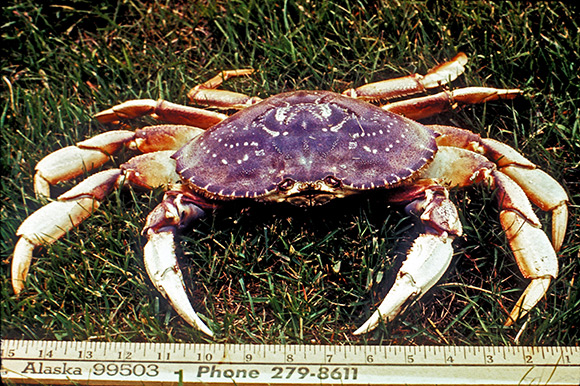
A Dungeness crab/USFWS photo
The Washington Department of Fish and Wildlife (WDFW) notes that Puget Sound summer crab-fishing seasons will get underway July 1 in many marine areas.
Crabbing will be closed on the July 4 holiday (summer seasons typically are closed on Tuesdays and Wednesdays). Also, extreme low tides during opening week will pose a challenge for people launching boats at some sites. As a result, recreational crabbers should target times with the least tide exchange and make sure their crab pots are properly weighted. Crabbers should also avoid deploying crab pots in ferry lanes because lines can cause serious damage to ferry boats.
WDFW will have creel staff at many boat launch and access sites this summer to gather information from recreational crabbers to help manage the crab fishery. The daily limit throughout Puget Sound is five hard-shell Dungeness crabs, males only, with a minimum carapace width of 6-1/4 inches. Fishers may also keep six hard-shell, 5-inch carapace red rock crabs of either sex per day in open areas.
Summer seasons and other information are posted on WDFW's crab-fishing webpage, https://wdfw.wa.gov/fishing/shellfishing-regulations/crab.
Limits reduced for Arizona rabbits, jackrabbits
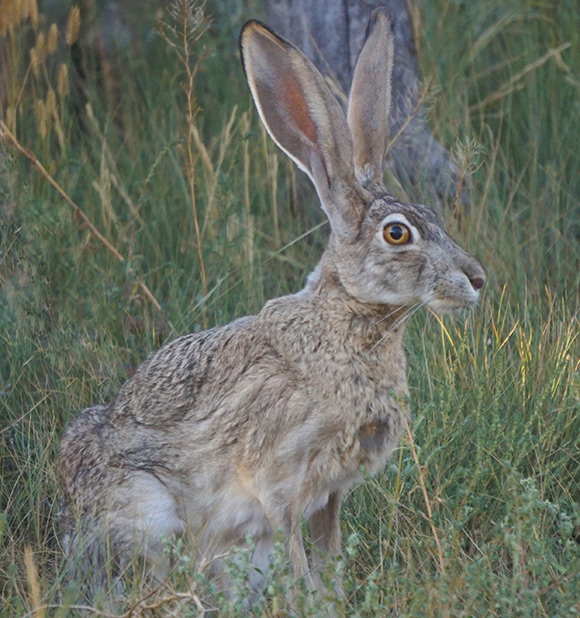
Jackrabbit - Mike Lewinski/Unsplash
The Arizona Game and Fish Department (AZGFD) advises small game hunters that reductions in the daily bag and possession limits for cottontail rabbits, and a daily bag and possession limit for jackrabbits, will become effective July 1. This move is a response to the impact of Rabbit Hemorrhagic Disease Virus Type 2 (RHDV-2) still occurring throughout the state.
The Arizona Game and Fish Commission voted to reduce the bag limit for cottontails from 10 to five per day and the possession limit from 30 to 15.
Also, previously Arizona had no limit on how many jackrabbits — both black-tailed and antelope — could be taken. On July 1, hunters may take two jackrabbits per day, possession limit six.
RHDV-2 is highly contagious disease among cottontails and jackrabbits. It’s spread by physical contact with bodily fluids, fecal material and even remains. While the meat is safe for human consumption, AZGFD encourages hunters to remove carcasses from the field and bury the remains deep enough to discourage coyotes and other scavengers from digging them up. Burying helps to limit the spread of RHDV-2.
RHDV-2 has been identified in Cochise, Graham, Greenlee, Pima, Apache, Navajo, and Coconino counties. AZGFD continues to investigate mortalities in new areas and asks that reports be made to the Wildlife Health Program (ajusticeallen@azgfd.gov) and Radio Room (623) 236-7201). For more information, visit www.azgfd.com/wildlife-conservation/wildlife-diseases/.
Lakes McConaughy, Ogallala campers need reservations
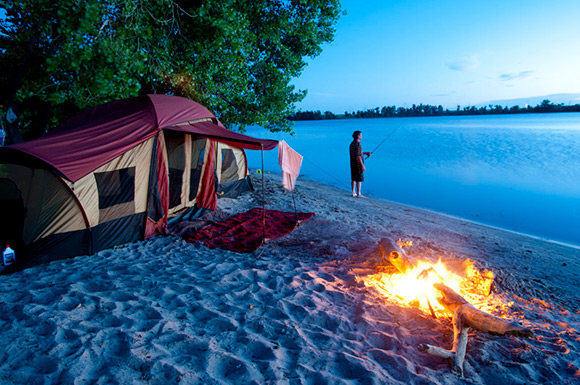
Camping along Lake McConaughy/Nebraska Game & Parks
With the July 4 holiday weekend rapidly approaching, campers are reminded they need a reservation to stay overnight at Lake McConaughy and Lake Ogallala state recreation areas in Nebraska. Campers should book their reservation at the two state recreation areas before leaving home. Reservations can be made online, via mobile app RA Camping, or by phone at 308-284-8800 during business hours.
Designated campground sites can be reserved 180 days prior to arrival date, and beach camping sites can be reserved 30 days prior to arrival date.
Same-day reservations may be made online or by phone until 5 p.m. Mountain time, if sites remain available. Once capacities are reached, no additional overnight camping will be allowed.
Day-use activities are not limited and do not require a reservation.
A park entry permit is required of each vehicle and can be purchased in advance online.
Boaters who register their motorized watercraft in any other state also must have an Aquatic Invasive Species Stamp each year they boat in Nebraska. This stamp, $15 for nonresidents, is available for purchase online. Learn more, make your reservation or buy your permit at OutdoorNebraska.gov.
Daisy National BB Gun Championship July 6 - 9
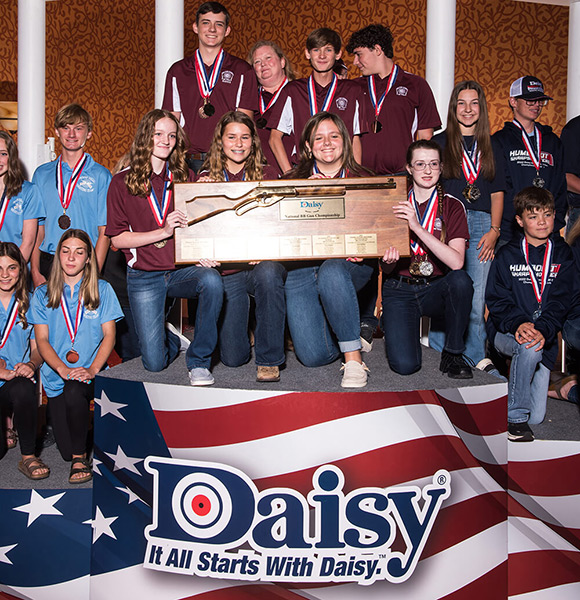
Daisy National Champions, 2022. Daisy
The Daisy National BB Gun Championship Match will bring teams of youth ages 8 to 15 from around the country to the Rogers Convention Center, in Rogers, Arkansas, to compete for the National Championship of BB gun shooting July 6 - 9.
The 5-meter, four-position NRA-sanctioned match is in its 56th year of competition and crowns Individual and Team National Champions.
Teams consist of five shooters and two alternates who have practiced and competed all year for the chance to qualify for the Daisy Nationals. Many teams originate in 4-H Shooting Sports programs, and come from as far away as Oregon, South Dakota, Virginian and Georgia to compete. This year 15 states will be represented.
All competitors shoot 10 shots standing, 10 sitting, 10 kneeling and 10 prone at an official 5-meter target with a Daisy Model 499B BB gun. Each shot is worth 10 points, 400 points total. Also, each competitor takes a test, covering gun safety and general gun knowledge, worth 100 points. So, each competitor is aiming for 500 points. Last year, Zoe Dissing set a new individual record with a score of 494 points.
Early registration begins July 5 - 6. July 7, competitors get practice time, take their tests, then attend the opening ceremonies. Competition commences July 8. Visit https://www.daisy.com/nationals/
ATV/UTV Riders: Get Smart Before You Start
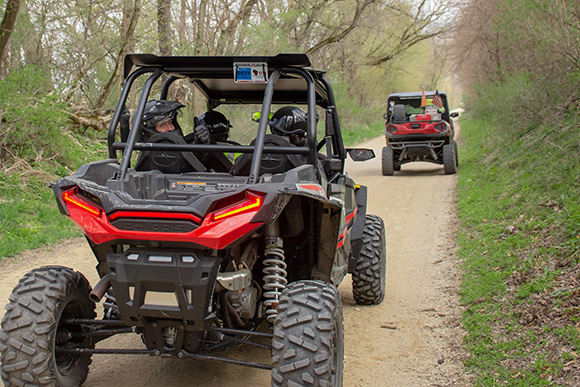
Wisconsin DNR Photo
The Wisconsin Department of Natural Resources wants to remind ATV/UTV riders to ride safe and always wear a helmet and seatbelt while riding trails and other routes. So far this year, WDNR says, there have been 11 fatalities due to ATV/UTV crashes. Most of the people involved were not wearing seat belts or helmets.
Make the safety of you and your passengers a top priority by riding sober (alcohol is a top contributing factor in crashes); riding at a speed that allows you to be aware of what's around and ahead of you at all times; wearing a helmet, seat belt and protective clothing; using extra caution on pavement.
One of the best things ATV and UTV operators can do to operate safely is to take an online safety course. A list of approved safety education classes is available on the DNR Safety Education webpage: https://dnr.wisconsin.gov/Education/OutdoorSkills/safetyEducation. All operators born after Jan. 1, 1988, are legally required to take the course. For more information on ATV and UTV recreation in Wisconsin, visit the DNR’s ATV/UTV riding in Wisconsin webpage https://dnr.wisconsin.gov/topic/atv
Gulf Coast flounders rebound
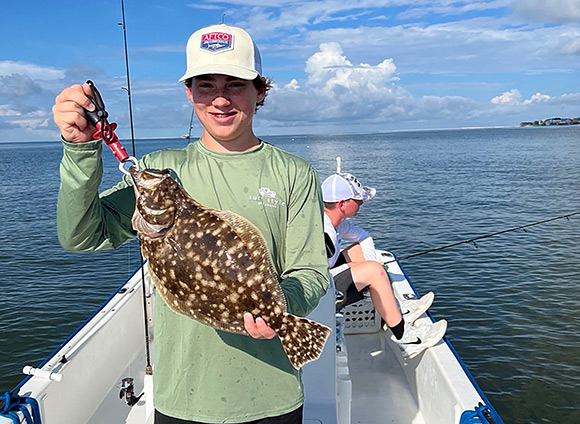
Anglers of all ages are starting to catch flounder again along the Alabama Gulf Coast. Jay Gunn photo/ADCNR
According to David Rainer, of the Alabama Department of Conservation and Natural Resources (ADCNR) both regulation changes and better environmental conditions have resulted in an encouraging flounder population rebound along Alabama’s Gulf Coast.
ADCNR’s Director of the Marine Resources Division Scott Bannon said stricter limits were adopted in 2019 because of a decline in the flounder population at that time. A commercial trip limit of 40 fish, and recreational bag limit of five fish, 14 inches or greater and a November no fishing limit helped.
Bannon said the November closure is the primary regulatory change that is having an impact. His barometers for an improved fishery? More anglers posting flounder photos on social media, phone calls from sport anglers who target flounder, Perdido Pass skin divers telling him the fishery is improving, even commercial fishermen saying flounders are doing better.
Yet Bannon doesn’t think the flounder rebound is totally the result of regulation changes. Environmental changes – improved water quality – also helped.
Also, work done at the Claude Peteet Mariculture Center in Gulf Shores, where Bannon’s staff has been spawning flounder in large tanks and releasing fingerlings into estuaries with the best water conditions for survival, helped. In 2020, 12,000 fingerlings were released; followed by 34,000 in 2021; and 102,000 in 2022. As of June, about 35,000 1-inch fingerlings have been released.
Visit https://www.outdooralabama.com/fishing/saltwater-fishing for more information.
Avoid a boating fuel mishaps

Gas pump pix - Jasper Garratt/Unsplash
Gas pumps no longer provide clear and transparent information to help boaters make the right fuel choice. Often, they’re a marketer’s dream, chock full of attention-grabbing videos blasting amplified sound to visually plaster a captive audience with eye-catching advertisements.
However, the Boat Owners Association of the United States (BoatUS) wants to remind boaters that recreational boats are not approved for gasoline blends containing more than 10% ethanol (E10).
Fuel retailers market E15 (15% ethanol) fuel – marked “regular 88” or “unleaded 88” as a lower cost alternative to E10. But recreational vessels are never compatible with E15. Federal law prohibits E15 fuel in boats, motorcycles, off-road vehicles and power equipment because it voids engine warranties and has been proven to cause damage to marine engines.
Any pump dispensing E15 fuel must have an approved orange warning label. BoatUS urges boaters to check the pump for the orange warning label denoting a higher-blend ethanol fuel.
Visit www.boatus.com for more information.
Protect nesting loons and their chicks
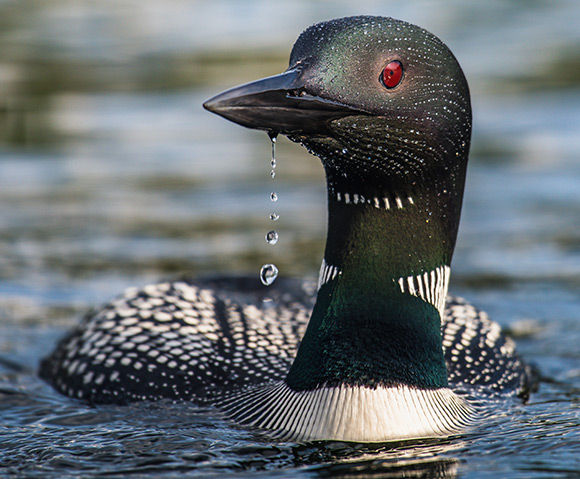
Loon - Jeremy Hynes/Unsplash
Few experiences rival hearing the haunting call of a loon or seeing these birds glide along in protected coves on a Vermont lake. However, Vermont Fish and Wildlife (VFW) is asking boaters and anglers to enjoy loons from a safe distance this summer for the birds’ protection.
“Loons were removed from Vermont’s endangered species list in 2005, but they face continued threats from human disturbance during the breeding season and ingestion of fishing gear,” said VFW wildlife biologist Rosalind Renfrew.
Many, but not all, loon nesting areas are marked by signs reminding people to give loons space, she noted, so VFW is asking people to enjoy loons from a distance, whether in a boat or on shore.
She also reminds anglers to avoid using lead fishing tackle. While lead sinkers weighing half an ounce or less are prohibited, Vermont still loses loons due to lead poisoning from swallowing tackle. Also, anglers should be careful not to attract loons to their bait and lures, and not leave fishing line behind, since it can entangle and kill loons. Vermont Loon Conservation Project biologist Eric Hanson suggests anglers reel in for a few minutes if loons are diving nearby. The Vermont Center for Ecostudies will place collection tubes for lead tackle and discarded fishing line at more than 20 boat access areas this summer.
Volunteers interested in monitoring loons should contact Hanson at loon@vtecostudies.org.
Volunteers can also survey one or two lakes on Loonwatch Day on July 15, 8 - 9 a.m. The goal is to survey all lakes greater than 20 acres to provide a population count for less frequently surveyed small lakes.
Expect to See Snakes
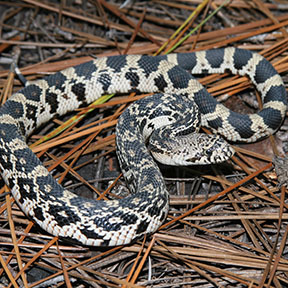
Northern pine snake hatchlings (Jeff Hall Photo/NC Wildlife Commission)
Warm weather means snakes will show up along North Carolina trails, in the woods, crossing roads and in yards, says the state Wildlife Commission. Wildlife Diversity biologists request that if you see a snake, don’t be alarmed, don’t kill it, give it plenty of room. Most snakes will leave people alone if they aren’t bothered and are provided an escape route.
If you see a pine snake or rattlesnake, however, report it.
“Snakes play crucial roles within ecosystems and help control the rodent, slug and insect populations,” said Jeff Hall, reptile conservation biologist with the commission. “There are many ways to coexist with snakes, which is important because of 38 of North Carolina’s native snake species, 10 are listed endangered, threatened or of special concern.”
Of six venomous native snakes in the state, three are rattlesnakes – the timber, the pigmy and the Eastern diamondback. Each is in decline, mainly through persecution by humans and habitat destruction. All are protected by the state Endangered Species Act.
The northern pine snake, also protected, is a native, threatened, nonvenomous snake. Biologists want to know more about its range and request the public report any sightings. Pine snakes prefer open areas in pine-oak forests with well-drained, sandy soil in the Sandhills and the southern Coastal Plain, although confirmed reports put pine snakes in Cherokee and Swain counties, too.
Snake sightings can be reported via the HerpMapper mobile app (visit http://herpmapper.org to download) or by email. Email reports must include a photo, date and time the snake was spotted and the location (GPS coordinates preferred). Email reports to pinesnake@ncwildlife.org for Northern pine snakes and to rattlesnake@ncwildlife.org for rattlesnakes.
Second northern snakehead found in Missouri

Northern snakehead/USGS photo
Fisheries biologists with the Missouri Department of Conservation (MDC) have confirmed a second invasive northern snakehead fish was caught by an angler May 19 while seining for bait at Duck Creek Conservation Area in Wayne County. The first northern snakehead recorded in Missouri was caught in a borrow ditch within the St. Francis River levees in Dunklin County in 2019.
MDC staff spent two days looking for additional snakeheads on Duck Creek and Mingo National Wildlife Refuge, but found no additional fish, indicating they’re in the area, but at low numbers.
Northern snakeheads were first discovered in eastern Arkansas waterways in 2008. Since then, these invasive have been spreading north through the St. Francis River watershed.
Snakeheads are an invasive aggressive predator, native to Asia, that prey on native species and compete for resources. If you find a northern snakehead, MDC recommends confirming it’s a snakehead – they can be confused with the native bowfins – and killing the fish by severing the head or gutting it. Snakeheads have a snake-like appearance with a much longer anal fin than the bowfin, breath air and can live a long time out of the water. Also, photograph the fish so the species can be positively identified, then report any sightings to MDC’s Southeast Regional Office at (573) 290-5858.
It is illegal to import, export, sell, purchase, or possess a live northern snakehead in Missouri.
Learn more at mdc.mo.gov/discover-nature/field-guide/snakeheads.
National Deer Assn., MeatEater to host public land work
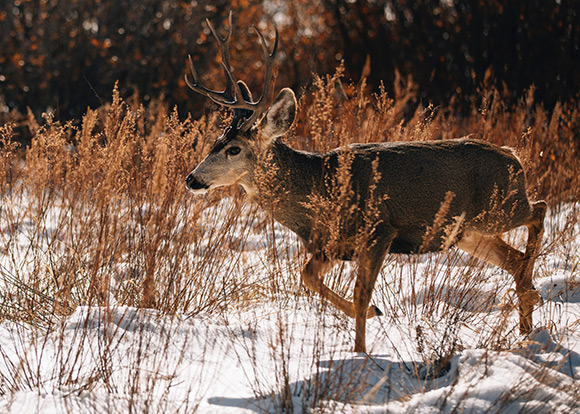
Mule deer - Joe Dudeck/Unsplash
The National Deer Association (NDA) is teaming up with Mark Kenyon of “Wired to Hunt” and “MeatEater” to host three Working for Wildlife Tour volunteer workdays on public hunting land. NDA will host the following workdays:
• Saturday, July 29, in the Idaho Panhandle National Forest, to remove encroaching conifers in aspen stands with the U.S. Forest Service, Idaho Fish & Game and First Lite
• Saturday, Sept. 23, in Mississippi’s DeSoto National Forest and Leaf River WMA to create and enhance early successional habitat, with the U.S. Forest Service, the Mississippi Department of Wildlife, Fisheries and Parks and Mississippi Power
• Saturday, Oct. 14, in Kentucky’s Daniel Boone National Forest, to collect white oak acorns for a local reforestation project with the U.S. Forest Service, Kentucky’s Division of Forestry, the Kentucky Department of Fish and Wildlife Resources, the University of Kentucky and the Independent Stave Company.
The Working for Wildlife Tour elevates the need and opportunity for folks to come out and chip in on public lands and brings attention to the critical work hunters and anglers do to create, conserve and restore wildlife habitat through volunteer on-the-ground projects.
To register for these NDA events, visit https://deerassociation.com/wfw/.
Bear conflicts on the rise
.jpg)
Black bear - Pete Nuij/Unsplash
Bear conflicts increase during the summer months according to both Minnesota and Vermont wildlife officials.
In Minnesota, for example, a woman was recently injured by black bear near Nisswa. She was staying at a cabin near Gull Lake and let her dog outside shortly after midnight. When she went into the yard to check on her dog, the bear swiped at her, striking her in several places. The bear left the immediate area after the incident.
The woman’s injuries were serious but not life-threatening. She was treated and released from the hospital.
Prior to the incident, no reported complaints of bear activity were recorded. Minnesota Department of Natural Resources (MDNR)wildlife officials believe the bear was likely startled by the quick appearance of the dog, then swatted the woman to defend itself. Cass County’s Sheriff and MDNR conservation officers monitored the area for bears posing a threat to public safety following the incident. Black bears are rarely aggressive and attacks on people are uncommon: There have been 10 bear attacks involving serious injury, but no deaths, in Minnesota since 1987, DNR says. Most involved attractants – birdseed, trash, or another food source – or dogs. Bears acclimated to people become more unpredictable when stressed. DNR says people should remove food sources, feed pets indoors, store trash in bear-proof containers and keep BBQ grills clean to avoid bear conflicts. For more tips visit https://mndnr.gov/bearsafety
Vermont officials have a similar message.
During 2022, reported bear incidents spiked from 206 in May to 473 in June, causing the Fish and Wildlife Department (VFWD) to increase their outreach efforts to prevent bear conflicts during the summer. By May 27 this year, VFWD already received 136 bear conflict reports – despite a stable, not increasing, bear population.
The leading cause of bear conflicts in Vermont is unsecured garbage, including household trash collection bins and dumpsters at businesses and campgrounds. Keeping garbage bins inside, until a few hours before trash collection can significantly reduce the risk of residential bear conflicts. Insisting garbage collectors provide bear-proof dumpsters reduces conflicts in other locations.
A fed bear is often a dead bear, officials also note. The most common unnatural bear-attracting food sources are pet food, bird feeders, barbecue grills, garbage, household trash containers, open dumpsters and campsites with accessible food or food wastes. Purposely feeding a bear is illegal.
Steps for coexisting with bears are available on VFWD’s website. Visit https://vtfishandwildlife.com/learn-more/living-with-wildlife/living-with-black-bears. Also, anyone seeing bears where they shouldn’t be should report the incident, visit https://anrweb.vt.gov/FWD/FW/WildlifeBearReport.aspx.
What’s coming in August?
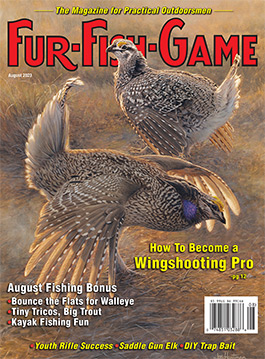
Don’t Overlook the Flats – Angler Wes David, has a good how-to on fishing the flats for August walleyes. He suggests bottom-bouncing the flats to catch fish and explains how to trigger less than actively feeding walleyes into hitting your bait.
Trapping With My Girls – Pat Donnelly shares his experiences with trapping with his daughters as they grew up. “Give your youngsters a try with trapping,” he writes. “Be prepared for wet clothes, cold feet and complaining now and then, but it’s worth it.”
Pathway To Wingshooting Success – Alan Davy has an important article about improving your gun mount to be a better wingshooter. Davy, like many of us, had several gun mount flaws before he researched the issue and found ways to correct his style and become a better shotgunner.
Tiny Tricos Catch Big Trout – Vic Attardo, FUR-FISH-GAME’s Fish and Tackle columnist shares a great article about how to fish Trico’s, those very tiny (No. 22 hooks!) and equally frustrating mayflies that can drive trout wild in late summer. Well worth the read for any fly fisherman.
Big Bore Air Rifles: Your Next Deer Rifle? – Jason Houser shares his experiences acquiring then hunting with a modern big bore air rifle for deer. Many states now permit the use of air rifles for big game and Houser wanted to try it, so he went to Texas and learned some things about the power of modern big-bore air rifles.
Some of the other articles in August include:
Rob Dankowski’s tips for catching big bronzebacks on topwatwer baits, especially effective after the sun goes down, are shared in Stay on Top for River Smallmouth. Check out his photos, too.
Ron Peach looks at In Between Doves, a primer for finding out of the way locations to hunt doves.
Aubrey Smith has a fun article about how an almost fruitless bass fishing adventure with his father resulted in both of them taking a Bluegill Break from Bass. A companion piece by Jean Dawson looks at the way to prepare bluegills for the table and shares a great chart with four techniques.
Landon Wardell shares his story of how a couple of rifle failures ended up with him using his saddle gun, a Marlin 336 in .30-30, to tag his Utah elk, in Elk with a Saddle Gun.
Finally, Jerry Bush offers tips for choosing a kayak and Fishing Small Rivers with Kayaks
Our columnists share their insights, too:
• Predator Hunting’s Judd Cooney talks about his favorite predator firearms for near and far.
• Tom Miranda urges fellow trappers to join him in attending Neil Olson’s New England Trapper’s Weekend in Out and About.
• Fish and Tackle’s Vic Attardo discusses summer bluegill tactics.
• The Trapline’s Hal Sullivan looks at DIY trapping bait, a column any trapper should consider.
• Gary Schroeder’s Fur Market Report, in addition to its always insightful and ahead of the curve market prices, discusses how the “crowd” is often headed in the wrong direction when it comes to fur buying.
• The Gun Rack’s, guest columnist Jeffery Miller talks about how he outfitted daughter Maia with her first deer rifle and how that didn’t turn out quite like he expected.
• Antique Trap Collecting’s Tom Parr shares a fascinating look at some early trapping magazines.
• The Question Box’s Randall Davis answer’s reader questions about ticks, a two-shot rifle sight in process, the bark-howl coyote call and what it means and more.
End of the Line Photo of the Month
Len & Tim Anderson, Clintonville, Wisconsin
SUBSCRIBE TO FUR-FISH-GAME Magazine

